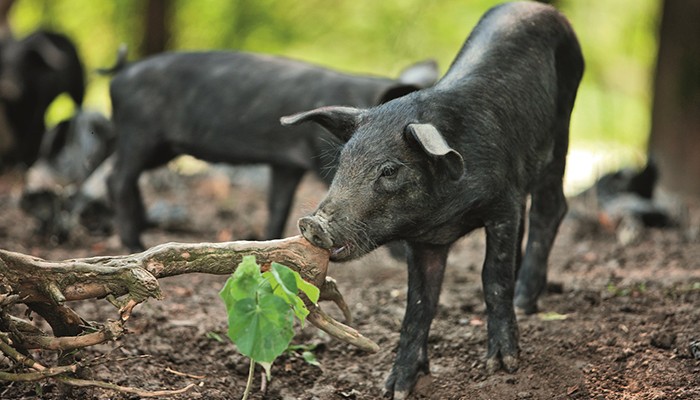

If you have not yet tried kulen (paprika flavoured salami), ham, bacon, even smoked ham (prosciutto) made from black Slavonian pig or far known Mangul pig goulash – as if you have never eaten before
The pride of Symria and Slavonia – the indigenous black Slavonian pig, originates from the 19th century in Orlovac, at the estate of the count Pfeiffer, which is why people call it the Pfeiffer in this region. Hybridization of Mangul (you will find more about it later) with Berkshire pig, later with imported black sorts like the oldest American sort Poland China, improved the features of the then pig sorts.
Even though black Slavonian pig is under the protection of the National programme for preservation of indigenous and endangered domestic animal species, it is comforting to know that the figures grow from year to year. Namely, there were only 237 black Slavonia sows in Croatia in 2001, but few years alter the number grew to 897. There are more and more growers of this pig sort, despite all aggravating circumstances. Here is only one of them: the butchers in pursuit of profit still prefer hybrid sorts which gain weight between 120 and 150 kg in only six months, whereas it takes between 13 and 18 months for black Slavonian pigs to achieve that many kilograms. Still, due to meat quality – which is of darker colour – there is a high content of intermuscular fat and higher muscle fibre consistency, so they will claim in Syrmia that kulen, ham, Slavonian sausages are the best when made of black Slavonian pig, but you will have to come to this part of Croatia and make sure it is as they say.
Not even the domestic smoked ham produces can resist it, a few years ago people from Dugopolje in Dalmatian part Zagora smoke Dalmatian smoked ham made of this pig sort. There are only three hundred of them a year, but nevertheless, they are still highly appreciated and wanted delicacy, and no one asks for price. Great quality is proven by the fact that during one blind tasting most eno-gasto journalists’ votes were given to it, as they preferred this to imported Hungarian and Austrian pigs, and they won. They are of darker colour with more fat and simply melt in your mouth. To lick your fingers!
Syrmian lucky charm
Mangul stew is one of the most famous dishes in Voivodina part of Syrmia. For those who know, Mangul is a sort of protected Hungarian pig, extremely highly valued because of its perfect pure meat and fat ratio. Some flatter it by calling it: “cholesterol free pig”. Though, some may be fulled at first sight and mix it with sheep because of its specific “fur” that reminds of sheep fur.
Due to its high fat percentage, Mangul meat is perfect for smoking and production of dry-smoked products. Even though it was close to extinction, Mangul has recently experienced a real revival – thanks to growers and chefs who were aware of the quality of this meat. Mangul goulash is made of loin and neck part, and Syrmian housewives like to add beer as secret ingredient. Otherwise, Mangul is so popular in Srem that there is a monument to it in Sremska Mitrovica. Mangul bronze statue, but also one of the traditional shepherd’s dog Pulin, can be seen in the town centre. You should only touch both muzzles of this statue and luck will knock on your door, so they say. Apart from being the most famous lucky charm in Voivodina, in Sremska Mitrovica they swear that their Mangul is a great ally in family planning. If it is to believe it, anyone who mounted the statue would have a baby in nine months. As they say – you can even choose – for a male offspring you should touch the right testicle with your right hand, and for a female offspring you should touch the left testicle with your left hand. „The time has passed when every other person would sit on the pig. Nowadays they only take pictures of it”, disappointedly said one older gentleman from Sremska Mitrovica.